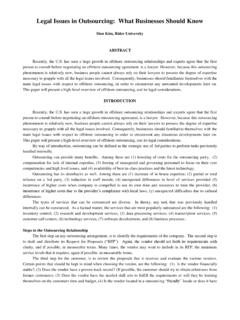Transcription of INSURANCE TRAPS FOR CONTRACTORS ON …
1 INSURANCE TRAPS FOR CONTRACTORS ON construction PROJECTS: HOW TO RECOGNIZE AND AVOID THEM By: Patrick J. Higgins1 and Paul von Schenk2 Everyone is busy in the construction business. Between bidding, scheduling, and completing work, CONTRACTORS are always in motion. Throughout this process, CONTRACTORS tend to focus on what they do best building things. Today, however, a contractor must also understand the INSURANCE component of its work to protect its business. This includes recognizing and avoiding construction project INSURANCE TRAPS . We discuss below strategies to assist with this.
2 PART I RECOGNIZING contractor INSURANCE TRAPS Coverage Trap 1 Illusory Coverage You have INSURANCE for this job but no coverage As illogical as it may seem, INSURANCE companies have issued a policy to a contractor for a particular job (or geographic area), but then added endorsements or exclusions to the policy limiting or eliminating coverage for that job or area. In such a case, a contractor that pays the premium for the policy, and receives the actual policy, believes that it has coverage protecting its workers and business from bodily injury or property damage claims.
3 However, if an incident occurs, and the contractor tenders the claim to the INSURANCE company, the contractor may find that it has purchased the illusion of coverage, and nothing else. In such cases, the contractor may be faced with an uncovered claim. A case illustrating the point is 720-730 Fort Washington Ave. Owners Corp. v. Utica Fort. Ins. Builder-owner 720-730 Fort Washington Ave. Owners Corp. ( Fort Washington ) hired general contractor DNA Contracting ( DNA ) to renovate Fort Washington s building. DNA in turn hired subcontractor Rauman construction Company ( Rauman ) to perform masonry and roofing work for the project .
4 The contract between DNA and Rauman required Rauman, as the subcontractor, to purchase Commercial General Liability ( CGL ) coverage that included DNA and Fort Washington as Additional Rauman purchased such a policy. However, buried in that CGL policy were three exclusions that took this protection away from Fort Washington and DNA. First, the CGL policy did not cover bodily injury for any employee of Rauman injured in the course of the project work. Second, the CGL policy excluded coverage for roofing work, and third, the CGL policy excluded coverage for liability assumed under a contract.
5 No one at Fort Washington apparently understood that the CGL policy excluded the risks that Fort Washington thought were covered. 1 Patrick J. Higgins, Esq. is a partner at Couch White, LLP. He is a member of Couch White, LLP s construction law group and represents clients in construction project litigation and associated matters. Mr. Higgins can be reached at (518) 426-4600 or 2 Paul von Schenk is an Account Executive with Amsure, a division of ATCFSI, specializing in commercial risk management and INSURANCE for the construction and real estate development industries.
6 Mr. von Schenk can be reached at (518) 886-0612 or 3 26 503, 893 426 (Sup. Ct. Bronx County 2009). 4 Id. at 504-505. 2 During the project , Rauman employee Marcos Castellon suffered an onsite injury, allegedly from a falling concrete block. He brought suit in the Bronx County Supreme Court against Fort Washington as owner of the property. Mr. Castellon alleged that the concrete block fell on him because it was not adequately secured in violation of Labor Law 200, 240(1) and 241(6). He could not sue Rauman, his employer, because workers compensation, his exclusive remedy against Rauman, barred such a claim.
7 Upon receiving the suit papers, Fort Washington demanded coverage for the loss under Rauman s CGL policy naming it as an additional insured. Rauman s CGL insurer, Utica First Ins. Co. ( Utica First ), denied Fort Washington coverage based on the three exclusions cited above. Fort Washington sued Utica First. It claimed that Utica First had issued a worthless, misleading policy excluding the risks that it had been purchased to cover, and that public policy required that coverage be provided as intended. The Bronx County Supreme Court agreed that the policy was worthless and misleading, but still found against Fort Washington.
8 It held that parties to an INSURANCE contract chart their own course in their agreements. The buyer had to beware. There was no law or statute that required that First Utica provide a minimal level of coverage. Thus, Fort Washington should have confirmed that the CGL policy its CONTRACTORS and subcontractors provided for the job contained adequate coverage and protection. It did not, however, conduct this due diligence, so the fault lay squarely on its Rauman had no assets to speak of, so DNA and its INSURANCE carrier were left to pay the claim.
9 DNA had indemnified Fort Washington against such claims and had purchased proper CGL coverage for such a loss. The Fort Washington case is uncommon, but not It demonstrates why the illusory coverage trap exists: CONTRACTORS generally do not expect that a policy would exclude the coverage that they purchased it to provide. As a result, they may accept the policy without recognizing the danger, and start work without adequate coverage. Knowledge comes only after an injury or property damage on a construction project with the resulting claim and denial.
10 By then, it may be too late for the contractor . Coverage Trap 2 Not understanding the policy exclusions, endorsements, and insuring agreements limiting or eliminating INSURANCE coverage A similar issue arises when a contractor receives the policy that it expected, but does not understand that the standard policy purchased does not cover the intended risk. In this case, there is nothing misleading about the policy. The coverage trap exists because of the disconnect between what the insurer has covered, and what the contractor believes the insurer has covered.


